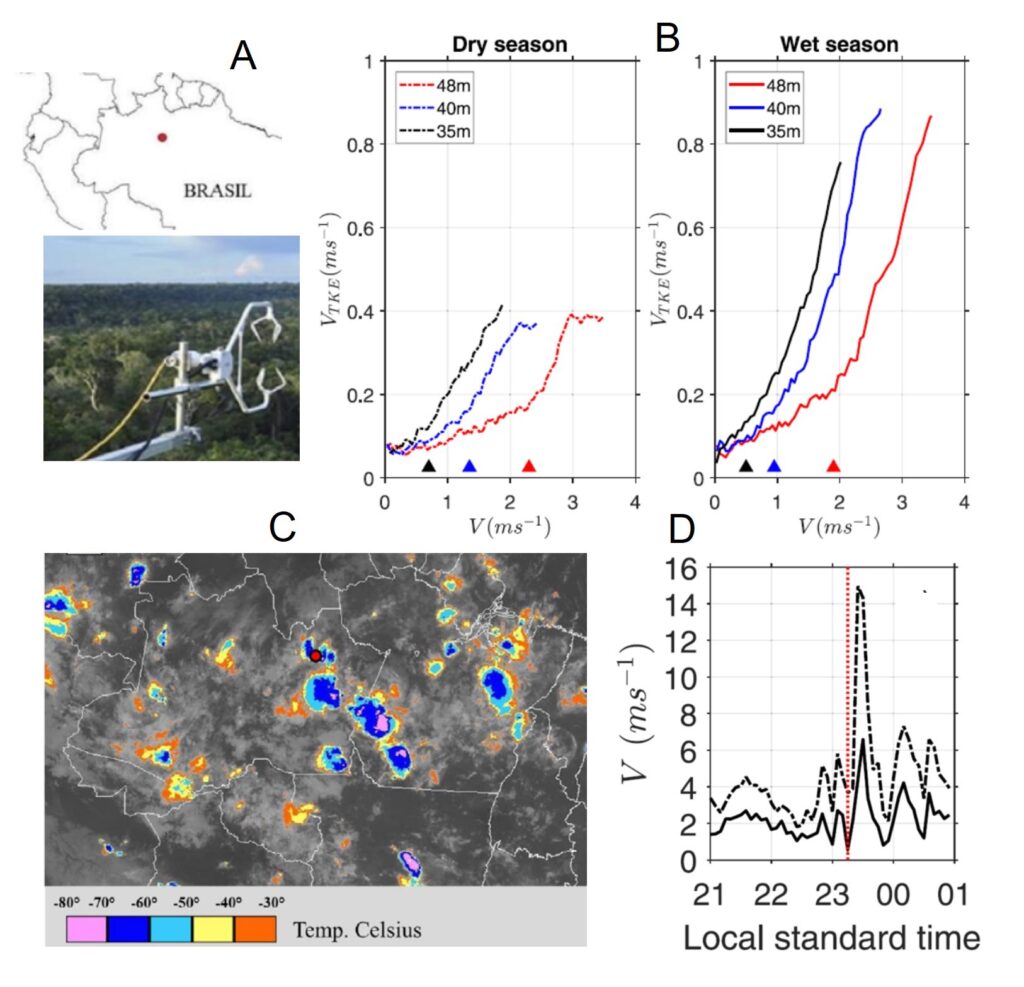Interplay of Turbulence Regimes, Deep Convection, and Tree Mortality in the Amazon Rainforest
The Science
With focus in the Central Amazon (Fig A), at the Tropical Silviculture Experimental Station -EEST (located about 60 km northwest of Manaus, 2°36′S, 60°12′W, 130 m ...) also known as ZF2, we investigated the influence of seasonality and proximity to the forest canopy on nocturnal turbulence regimes in the roughness sublayer (Fig B). Since convective systems of different scales are common in this region (Fig C), we also analyzed the effect of extreme wind gusts (propagated from convective downdrafts) (Fig D) on the organization of the turbulence regimes, and their potential to cause the mortality of canopy trees.
The Impact
Two different turbulence regimes were identified at three heights above the canopy: a weakly stable (WS) and a very stable regime (VS). The threshold wind speeds that mark the transition between turbulence regimes were larger during the dry season and increased as a function of the height above the canopy. Downdrafts occurred only in the WS and favored a fully coupled state of wind flow along the canopy profile.
Summary
Our study data include high-frequency winds, temperature and ozone concentration at different heights during the dry and wet seasons of 2014. In addition, we used critical wind-speed data derived from a tree-winching experiment and a modeling study conducted in the same study site. This study provides three novel contributions. The first was the identification of different turbulence regimes and their patterns in terms of seasonality and proximity to the forest canopy in the nocturnal roughness sublayer. The second was the assessment of the effects of near surface wind gusts (propagated from downdrafts) on the organization of turbulence regimes. Finally, it provides evidence on the occurrence of extreme wind gusts associated with convective downdrafts, with potential to promote damage and mortality of canopy trees. These aspects highlight the strong interactions between atmospheric and biospheric processes and mechanisms regulating forest structure and dynamics.

Figure. (A) Study area – Central Amazon, and high frequency sensor. (B) Relationship between turbulence velocity scale () and mean wind speed ( ) at different heights in the dry and wet season during the nighttime. Triangles indicate the threshold wind speed () at which the very stable changed to weakly stable regime. (C) GOES 13 image during 13 April 2014 at 0300 UTC when downdrafts reached the micrometeorology tower at the study area (red dot). (D) horizontal wind speed () over the sensor during 13 April.
Contact: Daniel Magnabosco Marra (Max Planck, Biogeochemistry), dmarra@bgc-jena.mpg.de
Funding
R Negron-Juarez was supported by the Next Generation Ecosystem Experiments-Tropics (NGEE-Tropics), funded by the U.S. Department of Energy, Office of Science. This study is part of the Wind–Tree Interaction Project (INVENTA) and the Amazon Tall Tower Observatory (ATTO), funded by the German Federal Ministry of Education and Research (BMBF, contracts 01LB1001A and 01LK1602A), the Brazilian Ministry of Science, Technology and Innovation (MCTI/FINEP, contract 01.11.01248.00) and the Max Planck Society (MPG), Germany.
Publication: Mendoca A, Dias-Junior C, Acevedo O, Santana R, Costa F, Negron-Juarez R, Manzi A, Trumbore S, Magnabosco Marra D. Agricultural and Forest Meteorology, 339, 109526 (2023), DOI: https://doi.org/10.1016/j.agrformet.2023.109526